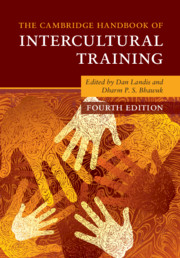Book contents
- The Cambridge Handbook of Intercultural Training
- Reviews
- The Cambridge Handbook of Intercultural Training
- Copyright page
- Dedication
- Frontispiece
- Contents
- Figures
- Tables
- Editors and Contributors
- Foreword
- Preface
- 1 Introduction and Theoretical Framework
- Part I Theoretical Foundations of Intercultural Training
- 2 Harry Triandis’s Contributions to Intercultural Training as a Field of Research
- 3 Interdisciplinary History of Intercultural Communication Studies
- 4 Culture Theories and Intercultural Training
- 5 An Analysis of Methods for Intercultural Training
- 6 Intercultural Simulations
- 7 Toward a Social Network Theory of Reentry
- 8 Intractable Conflict, Delegitimization, and Intercultural Training
- 9 Evaluation of Cross-Cultural Training
- Part II Practice of Intercultural Training
- Part III Indigenous Psychology and Intercultural Training
- Part IV New Interdisciplinary Approaches to Intercultural Training
- Part V Summing Up
- Index
- References
7 - Toward a Social Network Theory of Reentry
from Part I - Theoretical Foundations of Intercultural Training
Published online by Cambridge University Press: 18 September 2020
- The Cambridge Handbook of Intercultural Training
- Reviews
- The Cambridge Handbook of Intercultural Training
- Copyright page
- Dedication
- Frontispiece
- Contents
- Figures
- Tables
- Editors and Contributors
- Foreword
- Preface
- 1 Introduction and Theoretical Framework
- Part I Theoretical Foundations of Intercultural Training
- 2 Harry Triandis’s Contributions to Intercultural Training as a Field of Research
- 3 Interdisciplinary History of Intercultural Communication Studies
- 4 Culture Theories and Intercultural Training
- 5 An Analysis of Methods for Intercultural Training
- 6 Intercultural Simulations
- 7 Toward a Social Network Theory of Reentry
- 8 Intractable Conflict, Delegitimization, and Intercultural Training
- 9 Evaluation of Cross-Cultural Training
- Part II Practice of Intercultural Training
- Part III Indigenous Psychology and Intercultural Training
- Part IV New Interdisciplinary Approaches to Intercultural Training
- Part V Summing Up
- Index
- References
Summary
In this chapter, we make an argument that reentry process and its outcome could be better represented, understood, and explained from a social network perspective. We first review the theories and empirical findings of previous research on reentry using social relations as the binding theme. We then introduce social network analysis and highlight its complementary role to conventional reentry studies. On such basis, an integrated social network theory of reentry is proposed and its various propositions presented. FInally, the implications of this theoretical framework for intercultural training are discussed in detail and suggestions for training design and evaluation are provided.
- Type
- Chapter
- Information
- The Cambridge Handbook of Intercultural Training , pp. 281 - 305Publisher: Cambridge University PressPrint publication year: 2020



